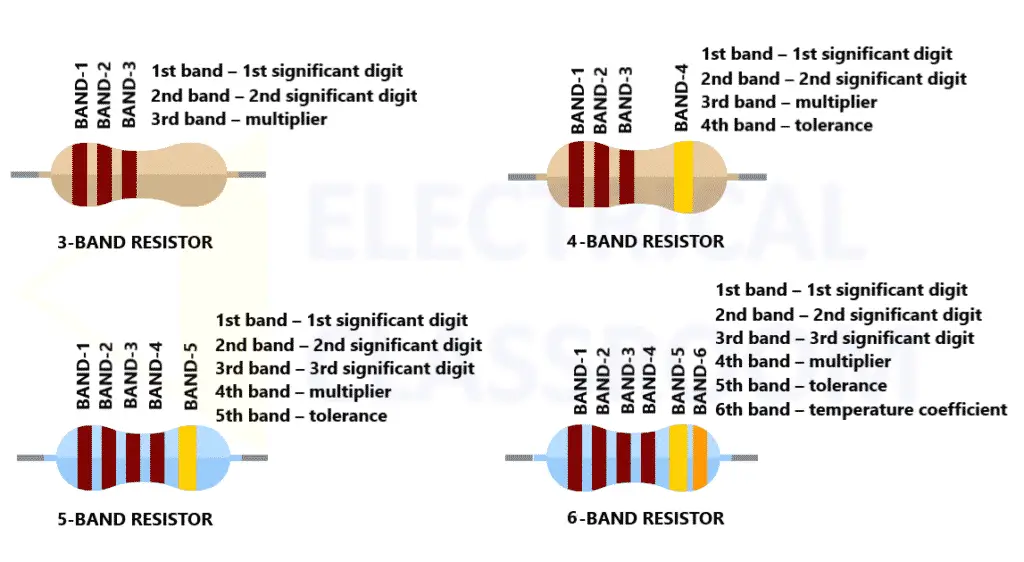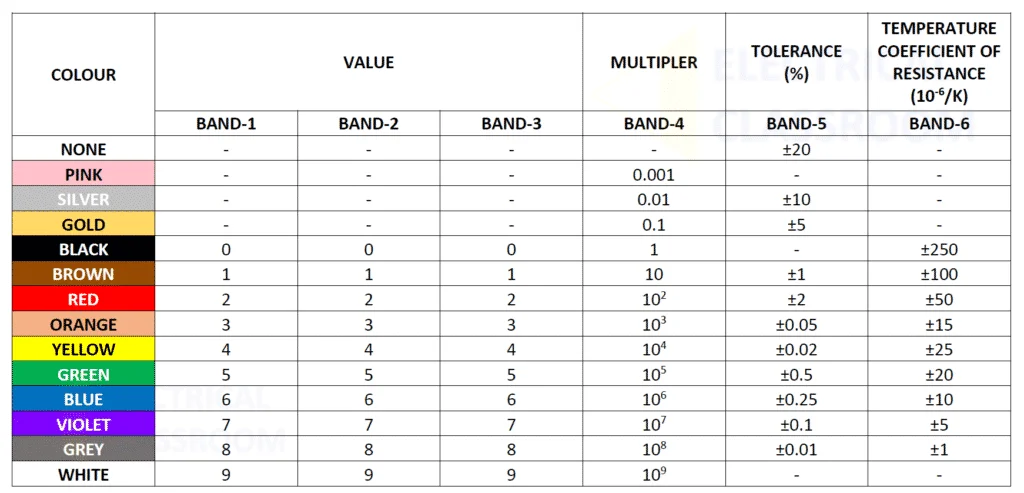Resistors are the basic building blocks of a circuit. They are used in circuits as voltage dividers, current limits, termination for communication links, etc. It is important to know how to calculate their ohmic value by referring to the color codes of the resistor. Here is a simple and easy-to-use resistance calculator.
Resistance calculator tool
Number of bands
The ohmic value of the resistor is:

How to use the resistance calculator?
If you are not good at reading color codes, this resistance calculator can be helpful to you. Select the band’s colors and let the tool work for you. Here are the steps to follow:
- Select the number of band marks marked on the resistor.
- Choose the color of each band and the tool will calculate the value of resistance for you. The color bands must be read from the right direction. Below are a few tips to identify the first band.
- Compare and verify the displayed image to your resistance.
How to identify the first band?
The color bands must be read from the right direction. If we are reading the bands in the wrong direction, we end up calculating the wrong value. Here are a few tricks to identify the first band of the resistors:
- The first band shall be closer to the end of the resistor. Hold the band closer to the end towards your left and start reading from the left.
- The tolerance band is usually 1.5 to 2 times wider than the other bands. If you can identify the tolerance band, hold it towards your right and start reading the colors from the left.
- Usually, the few color bands marked on the resistors are grouped into two. Place the larger group on the left and read the bands from left to right.
- Gold or silver bands normally indicate tolerance. If the gold or silver band is present closer to the end, it is definitely the tolerance band. Place the tolerance band on the right and read the bands from left to right.
How to calculate the nominal value resistance of a resistor?

In order to let you determine the nominal value of resistance, resistors have color bands printed over them. Each band has a specific number defined for every color. Using this their nominal value, tolerance, and expected resistance range can be determined.

Resistance calculation for 3-Band resistors
The first two bands of a 3-band resistor denote the first two digits of the resistance value and the third band denotes the multiplier.
- Band 1: First significant digit of the resistance value.
- Band 2: Second significant digit of the resistance value.
- Band 3: Multiplier.
Let us refer to the table above and calculate the ohmic value of resistor shown below:

- Band 1: Brown = 1 (First significant digit)
- Band 2: Brown = 1 (Second significant digit)
- Band 3: Brown = x 10 (multiplier)
- Ohmic value = 11 x 10 =110Ω
Resistance calculation for 4-Band Resistors
The first two bands of a 4-band resistor denote the first two digits of the resistance value, the third band denotes the multiplier, and the fourth band denotes tolerance.
- Band 1: First significant digit of the resistance value.
- Band 2: Second significant digit of the resistance value.
- Band 3: Multiplier.
- Band 4: Tolerance.

- Band 1: Green = 5 (First significant digit)
- Band 2: Blue = 6 (Second significant digit)
- Band 3: Red = x 100 (multiplier)
- Band 4: Gold = ±5% (Tolerance)
- Ohmic value = 56 x 100 =5600Ω ±5% = 5.6kΩ ±5%
Resistance calculation for 5-Band Resistors
The first two bands of a 5-band resistor denote the first three digits of the resistance value, the fourth band denotes the multiplier, and the fifth band denotes tolerance.
- Band 1: First significant digit of the resistance value.
- Band 2: Second significant digit of the resistance value.
- Band 3: Third significant digit of the resistance value.
- Band 4: Multiplier.
- Band 5: Tolerance.

- Band 1: Red = 2 (First significant digit)
- Band 2: Yellow = 4 (Second significant digit)
- Band 3: White = 9 (Third significant digit)
- Band 4: Orange = x 1000 (multiplier)
- Band 5: Gold = ±5% (Tolerance)
- Ohmic value = 249 x 1000 =24900Ω ±5% = 249kΩ ±5%
Resistance calculation for 6-Band Resistors
The first two bands of a 6-band resistor denote the first three digits of the resistance value, the fourth band denotes the multiplier, the fifth band denotes tolerance and the sixth band denotes the temperature coefficient of resistance.
- Band 1: First significant digit of the resistance value.
- Band 2: Second significant digit of the resistance value.
- Band 3: Third significant digit of the resistance value.
- Band 4: Multiplier.
- Band 5: Tolerance.
- Band 6: Temperature coefficient of resistance.

- Band 1: Red = 2 (First significant digit)
- Band 2: Yellow = 4 (Second significant digit)
- Band 3: White = 9 (Third significant digit)
- Band 4: Orange = x 1000 (multiplier)
- Band 5: Gold = ±5% (Tolerance)
- Band 6: Red = ±50 x ppm/ºC (Temp. Coeff.)
- Ohmic value = 249 x 1000 =24900Ω ±5% = 249kΩ ±5% ±50 x ppm/ºC
Read more articles like this: